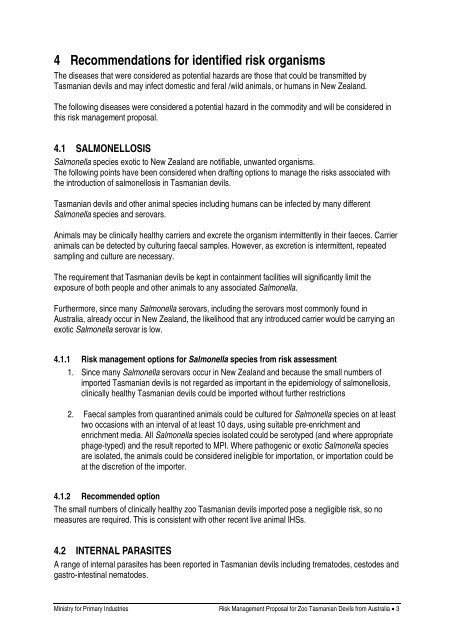Zoo Tasmanian Devils from Australia - Biosecurity New Zealand
Zoo Tasmanian Devils from Australia - Biosecurity New Zealand
Zoo Tasmanian Devils from Australia - Biosecurity New Zealand
Create successful ePaper yourself
Turn your PDF publications into a flip-book with our unique Google optimized e-Paper software.
4 Recommendations for identified risk organisms<br />
The diseases that were considered as potential hazards are those that could be transmitted by<br />
<strong>Tasmanian</strong> devils and may infect domestic and feral /wild animals, or humans in <strong>New</strong> <strong>Zealand</strong>.<br />
The following diseases were considered a potential hazard in the commodity and will be considered in<br />
this risk management proposal.<br />
4.1 SALMONELLOSIS<br />
Salmonella species exotic to <strong>New</strong> <strong>Zealand</strong> are notifiable, unwanted organisms.<br />
The following points have been considered when drafting options to manage the risks associated with<br />
the introduction of salmonellosis in <strong>Tasmanian</strong> devils.<br />
<strong>Tasmanian</strong> devils and other animal species including humans can be infected by many different<br />
Salmonella species and serovars.<br />
Animals may be clinically healthy carriers and excrete the organism intermittently in their faeces. Carrier<br />
animals can be detected by culturing faecal samples. However, as excretion is intermittent, repeated<br />
sampling and culture are necessary.<br />
The requirement that <strong>Tasmanian</strong> devils be kept in containment facilities will significantly limit the<br />
exposure of both people and other animals to any associated Salmonella.<br />
Furthermore, since many Salmonella serovars, including the serovars most commonly found in<br />
<strong>Australia</strong>, already occur in <strong>New</strong> <strong>Zealand</strong>, the likelihood that any introduced carrier would be carrying an<br />
exotic Salmonella serovar is low.<br />
4.1.1 Risk management options for Salmonella species <strong>from</strong> risk assessment<br />
1. Since many Salmonella serovars occur in <strong>New</strong> <strong>Zealand</strong> and because the small numbers of<br />
imported <strong>Tasmanian</strong> devils is not regarded as important in the epidemiology of salmonellosis,<br />
clinically healthy <strong>Tasmanian</strong> devils could be imported without further restrictions<br />
2. Faecal samples <strong>from</strong> quarantined animals could be cultured for Salmonella species on at least<br />
two occasions with an interval of at least 10 days, using suitable pre-enrichment and<br />
enrichment media. All Salmonella species isolated could be serotyped (and where appropriate<br />
phage-typed) and the result reported to MPI. Where pathogenic or exotic Salmonella species<br />
are isolated, the animals could be considered ineligible for importation, or importation could be<br />
at the discretion of the importer.<br />
4.1.2 Recommended option<br />
The small numbers of clinically healthy zoo <strong>Tasmanian</strong> devils imported pose a negligible risk, so no<br />
measures are required. This is consistent with other recent live animal IHSs.<br />
4.2 INTERNAL PARASITES<br />
A range of internal parasites has been reported in <strong>Tasmanian</strong> devils including trematodes, cestodes and<br />
gastro-intestinal nematodes.<br />
Ministry for Primary Industries Risk Management Proposal for <strong>Zoo</strong> <strong>Tasmanian</strong> <strong>Devils</strong> <strong>from</strong> <strong>Australia</strong> • 3
















